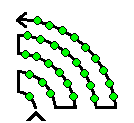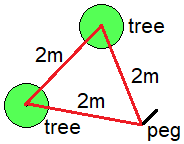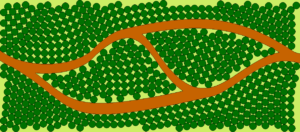The basic considerations are land, saplings and planters:
LAND – people allowing you to plant on their land. Ask, a lot of people want to do something.
SAPLINGS – collect acorns, chestnuts and beech nuts and grow them into saplings. If you can find the owner of your local garden centre ask if he has anything he can donate. Ask, a lot of people want to do something.
VOLUNTEERS – people to plant. Ask your friends. Declare a day and advertise it.
Talk to your friends and family. Tell them what you are doing. You will get used to the “What a wonderful idea” comments. Don’t be put off by the reluctant – it takes quite a lot for people to respond to an events that they see as a long way off.
You will need to consider funding. You can buy saplings – Woodland Trust’s Shelterbed tree pack gives a cost of 73p for 1 tree + 1 stake + 1 plastic spiral protector.
If you can, it is a good idea to grow your own saplings. You will need to collect seeds, plant them and watch over them. You will need to protect them from mice, who love nuts.
COLLECTING SEEDS
There are 6 types of tree recommended by the Forestry Commission for a climate changed England: Oak, Beech, Sweet Chestnut, Aspen, Wild Cherry and Norway Maple. The first three are easy to collect, Aspen is very difficult, Wild cherry is OK and Norway Maple is easy but don’t confuse it with Sycamore.
You can’t go far wrong if you plant what is already thriving in the area. The need for biodiversity is so great that you can plant anything that the locale will tolerate.
GROWING SAPLINGS
- Who will grow saplings – own land, volunteers work on others’ land, transport of volunteers, delivery from storage, planters and ‘growers’ separately.
- Donations of compost and pots ?biodegradable.
- Report-a-Sapling and Collect-a-Sapling; drop-off.
- Types of tree and seed – biodiversity – wide range needed: Alder, Ash (dieback), Aspen, Beech, Birch, Blackthorn, Buckthorn, Cedar, Chestnut, Cypress, Dogwood, Elder, Elm(resistant), Eucalyptus, Fir, Hawthorn, Hazel, Hemlock, Holly, Hornbeam, Horse Chestnut, Juniper, Larch, Lime, London Plane, Maple, Oak, Pine, Poplar, Rowan, Silver Birch, Spruce, Sycamore, Whitebeam, Willow, Wych Elm, Yew, and fruit trees : Apple, Cherry, Pear, Plum, Walnut.
FINDING LAND / Getting Permission
- Geographers, town & country planners
- Advertising for offers, friends of friends
- Request likely sources: churches, National Trust, Councils, gardening clubs, farmers, Soil Association, Woodland Trust (MOREwoods scheme), Royal Estates, Duchy, Woodland trust
PLANTING
- Organising work groups
- Organising tools
- Workers transportation & offers of transport
- Worker welfare & feeding etc.
- Return of tools & containers
- protection wraps (deer), fences, bramble cover
Equipment:
Spades, trowels, shears, buckets
Triangle of rope, 2m on a side
2m+2m lengths: 2m from last, 2m perpendicular to path
Method:
Before planting, make sure that you know:
- the path route,
- the method for boundaries – strict boundaries / overhang allowed / planting on the border allowed?
Start by marking out the path(s) – drag a spade along on its side to make the mark. If feet start to obscure the line then it will need remarking.
Place the first tree marker near the path in – you can use the sticks that are going to support the sapling and p rotection to indicate the positions. Place the second marker 2m from the first and no nearer than 1,m from the boundary or 2m from the path line.
rotection to indicate the positions. Place the second marker 2m from the first and no nearer than 1,m from the boundary or 2m from the path line.
Work in waves from one end on one side of the path and from the other end on the other side of the path. Use the triangle on the first two trees to position the third, and so on. You don’t have to worry about marking out the wave front, as you measure from two trees in the previous wave the next wave gets generated automatically.
You will need to be flexible: it won’t be exact, you can squeeze in by 20cm. Also don’t be too regular – more interesting walk if planting not too regimented.
too regular – more interesting walk if planting not too regimented.
If the next position (A, on the diagram) is within 2m of a path line, then move to B, which is also 2m from previous planting points but which is 2m from the path.

Other jobs:
Fetch and carry water
Mulch
Diggers
Measurers
Shearers
Weeders

If you have any thoughts you would like to share please send them via the Contact Us page.